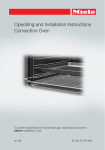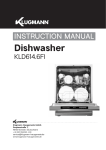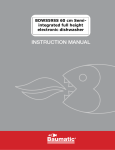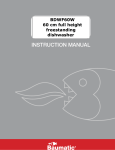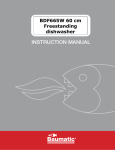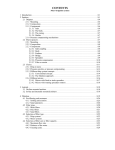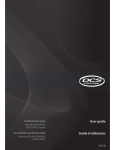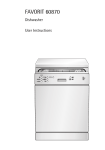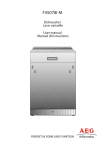Download Manual - FAST.Eu
Transcript
DISHWASHER USER'S MANUAL PD 1251 BiT Dear customer, Thank you for buying a PHILCO brand product. So that your appliance serves you well, please read all the instructions in this user's manual. CONTENTS PART 1: BEFORE PUTTING INTO OPERATION ................................................................................................. 2 Important safety instructions .....................................................................................................................................................2 PART 2: DESCRIPTION OF THE PRODUCT ....................................................................................................... 5 PART 3: INSTALLATION .................................................................................................................................... 6 Unpacking .........................................................................................................................................................................................6 Placement ..........................................................................................................................................................................................6 Electrical connection .....................................................................................................................................................................7 Water supply.....................................................................................................................................................................................7 Connecting the drain hose..........................................................................................................................................................8 Built-in.................................................................................................................................................................................................9 PART 4: CONTROL PANEL .............................................................................................................................. 11 Before first use .............................................................................................................................................................................. 12 Water softener .............................................................................................................................................................................. 12 Adding salt ..................................................................................................................................................................................... 13 Adding rinsing aid ....................................................................................................................................................................... 14 Function of the detergent ........................................................................................................................................................ 15 Dosage of the detergent ........................................................................................................................................................... 17 PART 5: WASHING DISHES / CUTLERY .......................................................................................................... 18 Filling the upper rack.................................................................................................................................................................. 19 Filling the lower rack .................................................................................................................................................................. 19 Setting the upper rack ............................................................................................................................................................... 20 Tilting down the tines in the upper rack ............................................................................................................................. 21 Basket for cutlery ......................................................................................................................................................................... 22 Turning on the appliance / starting a washing program .............................................................................................. 24 Changing a program .................................................................................................................................................................. 24 PART 6: MAINTENANCE AND CLEANING ...................................................................................................... 26 Filtration system ........................................................................................................................................................................... 26 Installing the filter ....................................................................................................................................................................... 26 Cleaning the filter ........................................................................................................................................................................ 27 Dishwasher care ........................................................................................................................................................................... 27 Protection against frost ............................................................................................................................................................. 28 PART 7: PREVENTION OF MINOR MALFUNCTIONS ..................................................................................... 30 Error codes ..................................................................................................................................................................................... 33 PART 8: TECHNICAL SPECIFICATIONS........................................................................................................... 34 EN - 1 Copyright © 2012, Fast ČR, a. s. 10/2012 PART 1: BEFORE PUTTING INTO OPERATION Important safety instructions Read carefully and store for future use. The safety of this appliance complies with industry norms and meets legal appliance safety requirements. However, as manufacturers, we consider it our duty to provide you with the following safety instructions. It is essential that you store this user's manual in a safe place so that you can use it in the future. If you intend to sell the appliance, give it to another owner, or if you move, always make sure that the user's manual is attached to the appliance, so that the new owner can find out about the operation of the appliance and the relevant warnings. Before installation or operation of the appliance you MUST carefully read all the safety instructions and the user's manual. Before putting the appliance into operation for the first time, check that it has not been damaged during transport. If the appliance is supplied in the winter months, when the temperature falls under 0°C, store the appliance at room temperature for 24 hours before first use. This dishwasher is designed for washing household dishwasher-safe dishes. Use the dishwasher only for the purposes for which it was designed. The dishwasher is designed for a maximum of 12 sets of dishes! This appliance must not be used by any persons (including children) with mental disabilities, weak strength or by inexperienced persons, unless they have been properly trained or schooled in the safe use of the product,or unless they are properly supervised by a qualified person who is responsible for their safety. Children must be supervised to ensure that they do not play with the appliance. Installation Check that the dishwasher has not been damaged during transport. Never connect a damaged appliance. If the dishwasher is damaged, contact the supplier. It is necessary to remove all packaging from the dishwasher before it is used. Dispose of the packaging materials in a proper manner. Do not allow children to play with the packaging material. There is a danger of suffocation! The electrical and plumbing installation necessary for the connection of this dishwasher may only be performed by a person with relevant qualifications. Maximum permitted water pressure is 1 Mpa. Minimum permitted water pressure is 0.03 Mpa. Connect the appliance to the water source using a new hose, do not use a used hose. The power cord must not be excessively or dangerously bent or pressed during the installation. For safety reasons, changing the technical parameters, or making any other modifications to the appliance is dangerous. Never use the dishwasher, if the electrical connection or the water hose are damaged, or if the control panel, workbench or its support is damaged, when the inside of the appliance is freely accessible. Contact a local service centre to avoid exposing yourself to possible dangers. You must not drill into any side of the dishwasher so that you do not damage the plumbing and electrical components. Do not turn on your dishwasher until all covers are properly installed. WARNING! When using the dishwasher follow all the notices below. EN - 2 Copyright © 2012, Fast ČR, a. s. 10/2012 Grounding instructions This appliance must be grounded. In the event of a failure or malfunction the grounding will reduce the risk of injury by electrical shock by ensuring a lower resistance to the electrical current. This appliance is equipped with a power cord with a grounding conductor and power plug. You must connect the power plug into an appropriate power socket installed and grounded in accordance with local laws and regulations. WARNING! The incorrect connection of the grounding conductor may create a risk of injury by electrical shock. If you have any doubts about the proper grounding of the appliance, ask a qualified electrician or service technician for verification. Do not modify the power plug included with the appliance, if it does not fit into the power socket. Ask a qualified electrician to install a proper power socket. Correct use Before inserting dishes or kitchen utensils, check that they are suitable for washing in a dishwasher. The manufacturer of the dishes or kitchen utensils will provide more details, or such information is included in the attached documentation. Not adhering to this notice may lead to the damage of dishes or kitchen utensils, or also the appliance. The warranty does not cover this kind of damage. Do not wash plastic items in the dishwasher unless they are marked by the manufacturer as dishwashersafe. For plastic items without such markings, follow the recommendations of the manufacturer. When using the dishwasher you should prevent the plastic items from coming into contact with the heating element. (These instructions are intended only for dishwashers with freely accessible heating elements.) Use only agents (detergents and rinsing aids, salt and polishing agents) designed to be used with automatic dishwashers. Never use soap, washing or cleaning detergents designed for hand washing. Keep all these substances out of the reach of children. Store all cleaning agents in a safe place. Keep children away from all washing and rinsing agents and at a sufficient distance from the open dishwasher door, because there could be remains of detergents inside. Do not use any solvents in the dishwasher. The could cause an explosion. Dishwasher detergents are very alkaline and their ingestion may be life threatening! Avoid contact with the skin or eyes, because there is a danger of chemical burns of eyes or skin. Keep children at a sufficient distance from the dishwasher when the door is open. Follow the safety instructions of the dishwasher detergent manufacturer. The water inside the dishwasher is not intended for drinking. It may contain remains of detergents. Place sharp items in such a way that they do not damage the door seal. WARNING! Knives and other utensils with sharp tines and blades must be placed inside the basket with tips facing downwards or in a horizontal position. Ensure that the dishwasher door is always closed, except for the time when dishes are being inserted or removed. This will prevent the danger of tripping over the door and subsequent injury. If the door is open, do not allow children to come close to the dishwasher. EN - 3 Copyright © 2012, Fast ČR, a. s. 10/2012 WARNING! Do not sit on the door or on the wire racks, do not stand on them or handle them with brute force. Do not touch the heating elements during operation or immediately afterwards. (These instructions are intended only for dishwashers with freely accessible heating elements.) Do not place any heavy items on the door when it is open and do not stand on it. The appliance could tip over. Open the dishwasher carefully during operation so that water does not spray out and so that you do not get scalded by the escaping steam. Do not pull any dishes out of the dishwasher until the cycle is completed. After the completion of a washing cycle, check that the detergent compartment is empty. After using the dishwasher, disconnect it from the power source and turn off the water supply. Under no circumstances tamper with the control buttons. Servicing, disposal If it is necessary to repair the appliance, contact an authorised service technician, who should use only original spare parts. If the power cord is damaged it must be replaced by the manufacturer or the manufacturer's service technician, to prevent injury to persons or damage to the appliance. Never attempt to repair the appliance yourself. Repairs carried out by inexperienced persons may lead to injuries or serious damage to the appliance. Contact a local service centre. Always request original spare parts. When taking an old dishwasher out of service or when disposing it, remove the dishwasher door. This will prevent children or animals from closing themselves inside the dishwasher and prevent this life threatening situation. EN - 4 Copyright © 2012, Fast ČR, a. s. 10/2012 PART 2: PRODUCT DESCRIPTION 1. 11. 2. 10. 9. 3. 4. 5. 8. 12. 6. 7. 1. 2. 3. 4. 5. 6. 7. 8. 9. 10. 11. 12. Upper rack with cup shelves Top spraying arm Lower rack Bottom spraying arm Filters Rating label Control panel Washing detergent and rinsing aid compartment Basket for cutlery Salt compartment (located in the bottom part of the appliance) Rail of the upper rack Active drying system for better dish drying results in the dishwasher EN - 5 Copyright © 2012, Fast ČR, a. s. 10/2012 PART 3: INSTALLATION Unpacking Remove the external packaging, remove the protective plastic film from the surface of the appliance (if used) and clean the external parts of the appliance with an agent designed for this purpose. Do not use steel wool or any coarse agents, which could irreparably damage the surface of the appliance. Carefully remove all papers and adhesive tape from the appliance, doors and other parts packed in polystyrene. Remove documents and accessories from inside the appliance. The packaging material is recyclable and is marked with a recycling symbol. For disposal follow the local regulations. Packaging materials (plastic bags, polystyrene parts, etc.) must be kept out of the reach of children, because they present a possible source of danger. Carefully inspect the appliance. If you discover any faults, stop the installation and contact the vendor. Placement Place the appliance in the desired location. The dishwasher is equipped with a water supply hose and a drain hose, which can be connected either on the right or left hand side of the dishwasher. Levelling the appliance After placing the dishwasher in its place it is not level, you can level it by using the levelling feet. Under no circumstances should the dishwasher be tilted by more than 2°. Connecting to a power source WARNING! For reason of personal safety: Do not connect to an extension cord or a multi-plug socket. Under no circumstances remove or cut away grounding from the power cord. Power source demands Information about the required voltage for the connection of the dishwasher to a suitable power source is contained on the appliance's rating label. Use the required 10 - 16A fuse, the recommended delaying fuse or circuit breaker and ensure that this appliance has its own independent electrical circuit. Before use, check that the appliance is properly grounded. EN - 6 Copyright © 2012, Fast ČR, a. s. 10/2012 Electrical connection Check that the voltage and frequency of the used power source correspond to the information on the appliance's rating label. Insert the power plug only into a properly grounded power socket. If the socket to which the appliance will be connected is not properly grounded, replace the socket rather than using adapters, etc., which could lead to overheating or burning. WARNING! The incorrect connection of the grounding conductor may create a risk of injury by electrical shock. If you have any doubts about the proper grounding of the appliance, ask a qualified electrician or service technician for verification. Do not modify the power plug supplied with the appliance. If the power plug does not correctly fit into your power socket, ask a qualified electrician to replace it. Water supply How to connect the water supply hose? You must connect the dishwasher to a water supply using a new hose. Do not use perished, old or otherwise damaged hoses. Water pressure must be in the range 0.03 MPa to 1 MPa. If the water pressure in your system is lower, ask for advice from our service department. Pull out the hose fully from the storage area in the rear part of the dishwasher. Screw in the water supply hose to a tap with a 3/4" thread. Fully open the water supply before turning on the dishwasher. Water supply hose The water supply hose has double wall. The water filling system guarantees intervention by blocking the water supply in the event that the water supply hose fails. WARNING! The hose connected to the water supply to the sink may break, if the sink is connected to the same water system as the dishwasher. We recommend that you disconnect the hose and seal the opening. EN - 7 Copyright © 2012, Fast ČR, a. s. 10/2012 How to disconnect the water supply hose? Shut off the water inlet. Reduce water pressure by pressing the reduce pressure button. This will reduce the water pressure and prevent water from possibly squirting out into the room. Unscrew the water supply hose from the water tap. WARNING! To prevent water from staying in the hose, close the water inlet into the dishwasher. (This does not apply to dishwashers with the aqua-stop function.) Connecting the drain hose Insert the drain hose into the waste water pipe with a minimum diameter of 4 cm or leave it lying in the sink and ensure that it is not bent or dented. Use a special plastic bracket supplied with the appliance. The hose must be at a height of 50 to 110 cm above the ground. The loose end of the hose must not be submerged in water so that reverse water flow does not occur. NOTE: The hose must be at a height of 50 to 110 cm above the ground. The loose end must not be submerged in water. EN - 8 Copyright © 2012, Fast ČR, a. s. 10/2012 Draining water Connect the drain hose. The drain hose must be properly attached so that water does not leak. Check that the hose is not knotted up or pinched. Extending the hose If you need to extend the drain hose, you must use the same type of drain hose. The hose must not be longer than 4 meters. Otherwise the efficiency of the dishwasher would be reduced. Connecting the drain hose You must connect the drain hose at a height from 50 cm (minimum) to 110 cm (maximum) from the bottom part of the appliance. Secure the drain hose using a clamp. The loose end must not be submerged in water. Built-in This dishwasher is designed to be built-in. Adhere to all warnings and instructions contained in this user‘s manual during installation. Before installation check that the required dimensions of the dishwasher to be built-in correspond to the dimensions of the installation location – see illustration below. EN - 9 Copyright © 2012, Fast ČR, a. s. 10/2012 After connecting the inlet and drain hoses, slide the dishwasher into the installation area. Take care not to damage, crimp, bend or otherwise impair any of the hoses. WARNING! Only remove the top cover if it is absolutely necessary for the installation into the built-in area. The dimensions of some built-in areas may be higher and so the dishwasher will fit in with the top cover attached. Turning on the dishwasher Before turning on the dishwasher, check the recommendation below. The dishwasher is levelled and properly seated. Is the inlet valve opened? Joints do not leak in the connection points. Cables are properly connected. Is the power source turned on? The water supply hose and the drain hose are not knotted up. You have removed all packaging material and all printed materials. EN - 10 Copyright © 2012, Fast ČR, a. s. 10/2012 PART 4: CONTROL PANEL Control panel 1. 2. 3. 4. 1. Power button (ON/OFF) Turning on/off power to the appliance. After turning on, the Start/Pause indicator light will come on. 2. Program selection button: press the button to select the desired program. 3. Delayed start button: the washing program can be postponed by 3, 6 and 9 hours. Repeatedly press the delayed start button (Delay) to select the length of the delay until the dishwasher is started. To activate the function press the Start/Pause button. If you wish to change the set time, press the Start/Pause button and then set a new value for the delayed start. Reconfirm using the Start/Pause button. If you press the delayed start button when the time is set to 12 hours, the delayed start indicator light will turn off. If at this time you press the Start/Pause button, the program will start. You can check the set delayed start value by looking at the control lights. For example, if you set 9 hours, the indicator lights 6 h, 3 h will gradually light up. 4. Salt warning indicator light: It will light up if salt needs to be refilled. Rinsing aid warning indicator light: It will light up if rinsing aid needs to be refilled. The warning indicator lights will turn off during the washing cycle or when using 3-in-1 tablets even if the amount is insufficient. End of program indicator light: as soon as the washing program finishes, the end of program indicator light will be lit. At the same time a sound will be made 5 times. NOTE: The washing program that was set previously will remain in the dishwasher‘s memory. Before turning on the dishwasher again, check that you have selected the correct washing program. Child lock function To prevent buttons from being pressed accidentally, it is possible to activate the child lock function. Hold down the Start/Pause and delayed start buttons at the same time for 4 seconds. The 3 h indicator light will flash once. To cancel the child lock function hold down the Start/Pause and delayed start buttons at the same time for 4 seconds. The 3 h indicator light will flash twice. EN - 11 Copyright © 2012, Fast ČR, a. s. 10/2012 Before first use Before you put your dishwasher into operation: a) set water softening; b) pour 3/4 litre of water into the salt compartment and fill it up with salt; c) fill the rinsing aid compartment; d) fill the dishwashing detergent compartment. Water softener The water softener is made so that it releases minerals and salts contained in water, which would have a negative effect on the operation of the dishwasher. The higher the content of these minerals and salts, the harder the water is. You should set the water softener according to the water hardness in your area. Information about water hardness in your area should be provided by your water supply company. If you use hard water in your dishwasher, scale deposits will be left on your dishes, which may negatively affect the washing efficiency and lifetime of your dishwasher. The appliance should be equipped with a special softener, which uses the salt compartment for salt specifically designed for eliminating scale and minerals from water. Identifying water hardness The dish washing efficiency of your dishwasher depends on the hardness of the water used. Therefore, your dishwasher is equipped with a system which reduces water hardness at the main water inlet. The better the system is set up the better the achieved washing efficiency. Your water supplier should provide you with information about water hardness in your area or you may measure it yourself using a simple harness test, a special testing strip (not included). Take the testing strip out of the packaging. Allow your tap water to flow over the strip for approximately 1 minute. Leave the Take it out of testing strip the water and dipped in tap it. the water for approximately 1 second. Wait approximately 1 minute for the result. 1 second 1 minute 1 minute Compare the hardness value on the strip to the hardness table supplied with the testing strip. Level 1 No Lime Level 2 Very low lime content Level 3 Low lime content Level 4 Medium lime content Level 5 Lime content Level 6 High lime content EN - 12 Copyright © 2012, Fast ČR, a. s. 10/2012 Setting salt consumption The dishwasher is designed to enable the adjustment of salt consumption on the basis of the hardness of the water used. This should optimise and adapt the level of salt consumption. Table for setting up water hardness Water hardness level 1 2 3 4 5 6 1. 2. 3. 4. 5. dH (German unit) 0–5 6 – 11 12 – 17 18 – 22 23 – 31 32 – 50 dF (French unit) 0–9 10 – 20 21 – 30 31 – 40 41 – 55 56 – 90 dE (English unit) 0–6 7 – 14 15 – 21 22 – 28 29 – 39 40 – 63 Water hardness setting indicator Indicator lights P1 and P5 are lit. Indicator lights P2 and P5 are lit. Indicator lights P3 and P5 are lit. Indicator lights P4 and P5 are lit. Indicator lights P1, P4 and P5 are lit. Indicator lights P2, P4 and P5 are lit. P1 P2 P3 P4 P5 Press and hold down the program selection button. In this time press the power button. Hold down the program selection button until the indicator lights P1/P2/P3/P4/P5 start flashing. Then release the button. Use the program selection button to set the water hardness level. To confirm and save into the dishwasher‘s memory press the power button. NOTE: Your water supplier will provide you with information about the hardness of your water. CAUTION! If your dishwasher does not have a water softening system, you can skip this chapter. Adding salt into the salt container Always use salt designed for dishwashers. The salt compartment is located under the lower rack and you should refill it in the following manner. NOTE Use only salt specifically designed for use in dishwashers! Any other kind of salt, which is not specifically designed for use in dishwashers, particularly table salt, would damage the softener system in the dishwasher. Damage caused by the use of inappropriate salt is not covered by the manufacturer's guarantee and the manufacturer takes no responsibility for any damages caused. Add the salt before starting one of the full washing cycle programs. This will prevent salt crystals or salt water from lying at the bottom of the dishwasher, where this could lead to corrosion. EN - 13 Copyright © 2012, Fast ČR, a. s. 10/2012 a) Slide out the lower rack and then unscrew the lid of the salt compartment – see pic. 1/2. b) Before the first wash, pour 3/4 litre of water into the salt compartment. c) Place the funnel (included accessory) on the opening of the compartment and pour 2 kg of salt into it. • It is normal for a smaller amount of water to run out of the compartment. d) After filling the compartment screw the lid back on by turning it in the clockwise direction. e) You should start a washing program immediately after the salt compartment has been refilled (we recommended the rinse or quick wash program). Otherwise the salt water could damage the filtration system, pump and other important part of the dishwasher. This is not covered by the warranty. NOTE Only refill the salt compartment when the salt warning indicator light on the control panel lights up. Depending on how well the salt dissolves, the warning indicator light may stay on even after the salt compartment has been refilled. If there is no salt warning indicator light on the control panel (on some models), you can estimate the amount after adding salt to the system by the number of cycles performed by the dishwasher. If salt runs out anywhere, remove it by starting the rinse program or the quick wash program. Adding rinsing aid Rinsing aid compartment The rinsing aid is released during the last rinse so that water drops do not remain on your dishes causing stains. It also improves drying due to the fact that all the water flows off the dishes. Your dishwasher is designed to only be used with a liquid rinsing aid. The rinsing aid compartment is located on the inside wall of the door next to the dishwashing detergent compartment. Fill up the compartment by opening it and pouring in the rinsing aid until the indicator goes completely dark. The capacity of the rinsing aid compartment is approximately 110 ml. NOTE: Use only branded dishwasher rinsing aids. Never pour other mixtures (such as liquid detergents, etc.) into the rinsing aid compartment. Otherwise the dishwasher may be damaged. When should the rinsing aid be refilled? If the rinsing aid compartment is empty, the relevant indicator light on the control panel will turn on indicating the need to add rinsing aid. After filling the compartment with rinsing aid the entire indicator is dark. As the rinsing aid is gradually used up the point of the indicator becomes smaller. Never allow the amount of rinsing aid to fall below 1/4 of the compartment volume. EN - 14 Copyright © 2012, Fast ČR, a. s. 10/2012 CAUTION Wipe any spilled rinsing aid with a wiping cloth, so that excessive suds are not formed in the following wash. Do not forget to put the lid back on before closing the dishwasher door. Setting dial (rinse) The rinsing aid compartment has six different settings. Its factory level setting is 3. If stains form on the dishes or if there is a problem with drying the dishes, increase the released amount of the rinsing aid by removing the lid and turning the dial to "4". If despite this step the dishes are not without stains after drying, adjust the setting again to a higher level until the dishes are clean after drying. If rinsing aid residues remain on the dishes, reduce the level to 1 – 2. The recommended setting is "3". (The value set by the manufacturer is "3".) NOTE: If there are water drops or scale stains on the dishes after the wash, increase the dosage. If there are white stains or blueish layers on glasses or knife blades, lower the dosage. Function of the detergent Dishwashing detergents with their chemical additives are essential for the removal of soils, their decomposition and removal from the dishwasher. For this purpose the majority of commercial quality dishwashing detergents are suitable. Dishwashing detergents There are 3 types of dishwashing detergents: 1. containing phosphates and chlorine; 2. containing phosphates and without chlorine; 3. without phosphates and without chlorine. New dishwashing detergents usually do not contain phosphates and so the softening function of the phosphates is missing. In such a case we recommended the use of a softening salt even when the water hardness is a mere 6°dH. If you use dishwashing detergents without phosphates and have hard water, this leads to the frequent appearance of white stains on dishes and glasses. In such a case you will therefore achieve better results if you add more dishwashing detergent. Chlorine-free dishwashing detergents whiten only slightly. For this reason strong and colourful stains will not be completely removed. In such a case select a program with a higher temperature. EN - 15 Copyright © 2012, Fast ČR, a. s. 10/2012 Concentrated dishwashing detergents Based on their chemical composition dishwashing detergents are divided into two basic types: standard, alkaline dishwashing detergents with caustic additives; less alkaline dishwashing detergents with natural enzymes. Using "standard" washing programs in combination with concentrated dishwashing detergents reduces pollution and is appropriate for your dishes. These programs are specifically improved with enzymes, which are contained in concentrated dishwashing detergents, that can dissolve soils. For this reason you can achieve the same results with concentrated dishwashing detergents using a "standard" washing program, as you would achieve only with the use of an "intensive" program. Dishwashing tablets The dissolving speed of various brands of dishwashing tablets may differ. For this reason some tablets may not dissolve during the short programs and therefore fail to perform their cleaning function. So when using tablets use the long programs to ensure the removal of all dishwashing detergent remains. Dishwashing detergent compartment You must fill up the compartment before starting any washing cycle according to the instructions contained in the dishwashing cycle table. Your dishwasher uses less dishwashing detergent and rinsing aid than an ordinary dishwasher. Generally a single tablespoon of dishwashing detergent is sufficient for a standard wash. For more heavily soiled dishes you will need more dishwashing detergent. Always add the dishwashing detergent immediately before starting the dishwasher, otherwise it could become damp and subsequently not dissolve completely. NOTE If the lid is closed, press the button. The lid will open. Always add the dishwashing detergent immediately before starting each washing cycle. Use only branded dishwashing detergents designed for dishwashers. WARNING! The dishwashing detergent is corrosive! Keep it out of children's reach. Using the dishwashing detergent Use only dishwashing detergent specifically designed for use in dishwashers. Store the dishwashing detergent in a dark and dry place. Do not put dishwashing detergent powder into the compartment unless you intend to start the dishwasher. EN - 16 Copyright © 2012, Fast ČR, a. s. 10/2012 Dosage of the dishwashing detergent 1. 2. 3. 4. 5. Release the clip to open the dishwashing detergent compartment. Place the required amount of dishwashing detergent into the main wash detergent compartment (if you are using a dishwashing powder). Make sure that the amount of the dishwashing detergent is between the MIN and MAX level lines. If the dishes are overly soiled, also add dishwashing detergent into the pre-wash partition. Close the dishwashing detergent compartment. Now turn on the dishwasher. NOTE: The mark „MIN” in the main wash detergent compartment corresponds to approximately 20g of dishwashing detergent. The pre-wash detergent compartment will take approximately 5g of dishwashing detergent. Follow the recommended dosages and storage indicated by the manufacturer on the packaging of the dishwashing detergent. Close the lid and press it down until it clicks in. If the dishes are heavily soiled, also add dishwashing detergent into the pre-wash compartment. This dose will be used during the pre-wash phase of the wash. NOTE: You can find the information about dishwashing detergent dosages in the washing program table. Keep in mind that the results may differ depending on the degree of soiling and hardness of the water used. Follow the manufacturer's recommendations on the dishwashing detergent package. EN - 17 Copyright © 2012, Fast ČR, a. s. 10/2012 PART 5: WASHING DISHES / CUTLERY Purchase dishes designated as dishwasher safe. Use a gentle dishwashing detergent marked as "gentle on dishes". If necessary seek out further information from the dishwashing detergent manufacturer. For certain types of dishes select a lower temperature. To prevent possible damage, remove glassware and cutlery from the dishwasher as soon as possible after the end of the wash. Unsuitable are: cutlery with wooden, bone or mother-of-pearl handles; plastic parts that are not heat resistant; older cutlery with glued parts that are not heat resistant; glued cutlery or dishes; tin or copper dishes; crystal glassware; metal parts susceptible to corrosion; wooden cutting boards; dishes made from synthetic fibres. Partially suitable are: some types of glass may corrode after several washes; silver and aluminium cookware may become discoloured by the wash; glazed patterns may fade if washed frequently. NOTE: Your dishwasher will achieve the best performance if you follow these instructions for inserting dishes into the racks. The function and appearance of the racks and the cutlery basket may differ depending on the model of the dishwasher. NOTE: Do not place any items into the dishwasher soiled by cigarette ash, wax, varnish or paint. When buying new dishes, check that they are dishwasher safe. First remove remaining or burned on foods. It is not necessary to wash dishes under running water. Insert the dishes into the dishwasher as follows. Items such as cups, glasses, pots / pans, etc., should be placed bottom up. Curved cookware and cookware with projections should be placed at an angle to allow water to freely flow out. Place dishes safely so that they cannot tip over. Place dishes in such a way that the spraying arms can rotate freely during the wash. NOTE: Do not wash very small pieces in the dishwasher because they can easily fall out of the rack. EN - 18 Copyright © 2012, Fast ČR, a. s. 10/2012 Hollow cookware, e.g. cups, glasses, pans, etc. should be placed bottom up so that water does not accumulate inside them during the wash. Dishes and cutlery must not be inserted into each other or to cover each other. To prevent damaging glasses, they must not touch each other. Place hard-to-clean large cookware in the lower rack. The upper rack is intended for lighter and fragile dishes, such as glasses, cups and mugs. Knives with a large blade placed in a vertical position are dangerous! Long and/or sharp cutlery, e.g. kitchen knives must be placed horizontally in the upper rack. Do not overfill your dishwasher. For better washing results and lower power consumption. Taking dishes out of the dishwasher To prevent water dripping down from the upper rack on to the dishes in the lower rack, we recommended you first empty the lower rack and only then the upper rack. Filling the upper rack The upper rack is designed for lighter dishes: glasses, cups and mugs and saucers, also small plates, small bowls and shallow pots (if they are not too soiled). Place the dishes in such a way that they will not be moved by the sprayed water current. Loading the lower rack We recommend you place larger cookware and hard-to-clean cookware into the lower rack: pots, pans, lids, serving plates and bowls. It is better to place serving plates and lids on the sides of the rack, so that the spraying arm does not become blocked. EN - 19 Copyright © 2012, Fast ČR, a. s. 10/2012 Remember that: pots, serving bowls, etc. must be place bottom up; deep pots should be placed at an angle so that water can freely run out of them; the tines on the lower rack can be folded, so that you can insert larger pots and pans or more smaller items. Special cookware, e.g. large pans or plates should be placed in the lower rack. The recommended placement is shown below. Incorrect arrangements of dishes Setting the upper rack Setting the height of the upper rack The height of the upper rack can be set so as to create more space for larger dishes in the upper / lower rack. The height of the upper rack can be set by inserting the wheels at various heights into the rails. Long pieces of cookware, eating utensils, ladles and knives should be placed in the rack so that they do not interfere with the rotation of the spraying arms. If you will not use a rack, you may tilt it down or even remove it. EN - 20 Copyright © 2012, Fast ČR, a. s. 10/2012 Setting the height of the side partitions You can set the height of the side partitions to create more / less room for larger / smaller glasses / cups in the top rack. At the same time the side partitions are divided into 4 smaller sections, so you can set 2 different heights on either side. Tilting down the tines in the upper rack The lower rack is equipped with special tilting tines making it possible to quickly and easily adjust the lower rack area based on your current needs. EN - 21 Copyright © 2012, Fast ČR, a. s. 10/2012 Basket for cutlery Place cutlery into the basket with the handle downwards. If the basket has side partitions, place spoons separately into the appropriate openings. Particularly long cutlery should be place in a horizontal position in the front part of the upper rack as shown in the picture. 1. Table spoons 2. Forks 3. Knives 4. Dessert spoons 5. Tea spoons 6. Ladles 7. Serving spoons 8. Serving forks WARNING! Ensure that no cutlery projects through the bottom of the basket. Always place sharp cutlery with the tip pointing downwards! For your personal safety and to achieve the maximum quality way place cutlery into the basket, ensuring that: individual items are not lying on each other; the cutlery is placed with the handle pointing downwards; place knives and other dangerous cookware with the handle pointing upwards. EN - 22 Copyright © 2012, Fast ČR, a. s. 10/2012 Program table Program Intensive wash Super (P2) (P1) Economical wash (P3) Quick wash Pre-wash Temperature 70°C 65°C 50°C 40°C - Food types Heavily soiled dishes for hygienic removal of soils Dishes soiled from soup, sauces, pasta, eggs, rice, potatoes, stewed meat, fried foods Lightly soiled dishes from coffee, milk, tea, cold meat, vegetables Lightly soiled dishes from coffee, milk, tea, cold meat, vegetables Pre-wash and removal of soils from dishes Degree of soiling High Medium Medium Low - Dishwashing detergent A: 25 cm³/ 15 cm³ B: 5 cm³ A+B A+B A+B A - Washing cycle process Pre-wash Wash 65°C Pre-wash Wash 40°C Pre-wash Wash 70°C Cold rinse Wash 50°C Cold rinse End Cold rinse Hot rinse Cold rinse Hot rinse Hot rinse End Hot rinse End Drying Drying End End Washing cycle time (min) 110 50 160 30 15 Electricity consumption (kW/h) 1.55 1.35 0.95 0.90 0.02 Water consumption (l) 16.5 12.7 15.7 12.4 4.5 NOTE (*): It is necessary to refill the rinsing aid into the compartment. EN - 23 Copyright © 2012, Fast ČR, a. s. 10/2012 WARNING! Short programs do not include the drying function. The above mentioned values were obtained on the basis of laboratory tests according to relevant standards. These values may change depending on conditions such as the type of dishes used, degree of dirtiness, type of dishwashing detergent, water pressure, water hardness, etc.). NOTE: The above provided values are only for your orientation. They have been determined on the basis of laboratory tests in accordance with respective standards. The values may differ depending on the conditions under which the appliance is used and other factors such as pressure, water pressure, water temperature, ambient temperature, etc. Turning on the appliance / starting a washing program 1. 2. 3. 4. 5. 6. 7. Pull out the lower and upper rack, load it with dishes and then slide back in. We recommend that you first load the lower rack and only then the upper rack (see “Load the dishwasher racks”). Fill the compartment with dishwashing detergent (see section “Dosage of the dishwashing detergent”). Connect the power plug to the power socket. Power source is 220 - 240 V ~ 50 Hz, power socket specification 12 A, 250 V ~. Check that the water inlet is fully open. Press the ON / OFF button. Use the program selection button to select the desired program. If necessary select an additional function. Close the door to automatically start the program. The indicator light of the selected program will turn off when the program is started. Monitoring the program You can monitor the progress of the washing cycle by watching the indicator lights on the control panel turn on and off. NOTE: Do not open the dishwasher until the ‘end of washing cycle’ indicator light turns on. During the drying process the dishwasher will not make any sound for 40 – 50 minutes. This is a normal event. Changing a program A) Changing a program that is already running 1. Carefully open the door. Wait until the spraying arms stop. Allow excess steam to escape. 2. Select a new program. 3. Close the door and the new program will start. B) Cancelling a program 1. Carefully open the door. Wait until the spraying arms stop. Allow excess steam to escape. 2. Press and hold the program selection button for approximately 3 seconds. The end of program indicator light will start flashing and the program indicator light will turn off. 3. Close the door and the dishwasher will automatically drain the water, approximately 30 seconds after the door is closed. After this a sound will be made 5 times. WARNING! It is dangerous to open the dishwasher door during a wash because you could be scalded by hot water. EN - 24 Copyright © 2012, Fast ČR, a. s. 10/2012 After the end of the washing cycle 1. 2. After ending the washing cycle the ‘end the program’ indicator light (End) will turn on. Press the ON/OFF button to turn off the dishwasher. Disconnect the power cord from the power socket and shut off the water inlet. NOTE: Wait a few minutes before taking dishes out of the dishwasher so that you do not handle the dishes while they are hot and more susceptible to breakage, and they will dry better too. NOTE: If you open the door during the washing cycle or an electrical power outage occurs, the washing cycle will be interrupted and it will resume after the door is closed or the electrical power supply is renewed. EN - 25 Copyright © 2012, Fast ČR, a. s. 10/2012 PART 6: MAINTENANCE AND CLEANING Filtration system The filter prevents food remains or other foreign items from entering the pump. Food remains may clog the filter and in such a case it is necessary to take it out. The filtration system consists of a coarse filter, a plastic filter and a micro-filter (fine filter). 1 Plastic filter Food remains and soils caught by this filter are pulverised by a special jet on the bottom spraying arm and flushed down the drain. 2 Coarse filter Larger parts, e.g. bits of bone or glass, which could clog the drain are stopped by the coarse filter. Remove the soils caught by this filter by taking the filter out - gently press the plug on the top of this filter and lift it up. 3 Fine filter This filter stops the remains of soils and food in the area of the water tank and prevent the remains from returning back to the area of the dishwasher during the wash. Installing the filter The filter effectively removes food remains from the water used to wash the dishes and so this water can be used repeatedly during the wash. You will achieve better wash results if you regularly clean out the filter. For this reason it is better to remove the food remains from the filter after every wash by flushing out the semi-circular filter and containers under running water. Take out the filter by pulling upwards on the container handle. WARNING! Never use the dishwasher without a filter. An incorrectly seated filter may lower the efficiency of the dishwasher and cause damage to dishes. EN - 26 Copyright © 2012, Fast ČR, a. s. 10/2012 1. 2. 3. To remove and clean the filtration system turn the filter anticlockwise and then lift it up. Pull out the metal/plastic filter. Take the course filter out of the fine filter. NOTE: Follow all the steps of this procedure remove the filtration system; then reinstall it by proceeding from step 3 to step 1. Recommendation: After every use of the dishwasher check that the filters are not clogged. You can take out the filtration system by unscrewing the coarse filter. Remove any food remains and clean out the filters under running water. NOTE: You should clean the entire filtration set once per week. Cleaning the filters To clean the coarse and fine filters use a brush. Reassemble the individual parts of the filter as shown on pictures 1, 2 and 3. Reinsert them back into the dishwasher in their place and press them downwards. WARNING! Do not knock on the filters when cleaning them. Otherwise the filters could bend, which would lower the efficiency of the dishwasher. Never use the dishwasher without a filter. An incorrectly seated filter may lower the efficiency of the dishwasher and cause damage to dishes. Dishwasher care You can clean the control panel using a light damp wiping cloth. Thoroughly dry the area after cleaning. Clean the exterior parts of the dishwasher using a quality polish. Never use any sharp items, steel wool or coarse, sandy cleaning products to clean any part of the dishwasher. EN - 27 Copyright © 2012, Fast ČR, a. s. 10/2012 Cleaning the door To clean the door edges use a soft, warm, damp wiping cloth. To prevent water leaking into the door lock or its electronic parts, do not use any cleaning agents in sprays. WARNING! Never use cleaning agents in sprays to clean the dishwasher door because this could damage the door lock and electrical parts. Do not use sandy cleaning agents or certain types of kitchen paper towels, because they could scratch or leave marks on the stainless steel parts of the dishwasher. Protection against frost In winter take steps against the dishwasher freezing. After every wash do the following: Disconnect the dishwasher from the power source. Close the water inlet and disconnect the supply hose from the water valve. Drain water from the water supply hose and the water valve. (Drain the water into a container.) Reconnect the water supply hose to the water valve. Take out the filter on the bottom of the dishwasher and using a sponge suck up the water from the waste tank. NOTE: If your dishwasher is not working because it has frozen, contact an authorised service technician. EN - 28 Copyright © 2012, Fast ČR, a. s. 10/2012 Cleaning the spraying arms It is important to regularly clean the spraying arms so that hard water minerals do not clog the jets and the bearings of the spraying arms. Detach the spraying arms by turning the nut clockwise, remove the washer from the spraying arm and then the spraying arm itself. Wash the spraying arms in warm soapy water and clean out the jets using a brush. After thoroughly flushing them reattach them. How to keep your dishwasher in good condition? After every wash After every wash close the water inlet into the dishwasher and leave the door slightly open so that humidity that would otherwise accumulate inside is ventilated out. Disconnect from the power socket Always disconnect the dishwasher from the power source before cleaning or any maintenance. No solvents or sandy cleaning agents Never clean the external or rubber parts of the dishwasher using solvents or sandy cleaning agents. Only use a wiping cloth dipped in warm soapy water. Remove stains from the surface of the dishwasher using a wiping cloth dipped in water with a little vinegar or a cleaning agent specially designed for dishwashers. When taking out of operation for an extended period We recommend that you run an empty cycle without dishes and then disconnect the dishwasher from the power source, shut off the water supply and leave the dishwasher door slightly open. This will help to increase the lifetime of the door seals and will prevent the accumulation of odours inside the dishwasher. Moving the appliance In the event that you need to move the appliance, you must move it in the vertical position. If it is really necessary place it down on its rear side. Seal One of the factors causing odours inside the dishwasher is food remains, which get caught in the seals. You can prevent this by regularly cleaning with a damp sponge. EN - 29 Copyright © 2012, Fast ČR, a. s. 10/2012 PART 7: PREVENTION OF MINOR MALFUNCTIONS Problem Possible causes What to do A burned fuse or the circuit breaker is off. Replace the fuse or turn on the circuit breaker. Disconnect any other appliances sharing the same circuit. Power source is not turned on. Check that the dishwasher is turned on and the door is shut properly. Check that the power plug is correctly connected to the power socket. Water pressure is low. Check that the water supply is correctly connected and whether it is open. The dishwasher door is not closed properly. Check that the door is closed properly and secured with the latch. There is a knot on the drain hose. Check the drain hose. The filter is clogged. Check the coarse filter (see section "Cleaning the filters"). The kitchen sink is clogged. Check the kitchen sink and ensure that it drains well. If the problem is an incorrectly draining sink, first call a plumber and only then the service technician. An incorrect dishwashing detergent was used. Use only special detergents for dishwashers to prevent the formation of suds. If this occurs, open the dishwasher and allow the suds to evaporate. Pour 0.4 l of cold water into the dishwasher. Close the dishwasher to the latch and then start the rinse cycle to drain the water. Repeat if necessary. The rinsing aid has spilled out. Always immediately clean the rinsing aid. There are stains inside the dishwasher. You have used a dishwashing detergent with dyes. Use a dishwashing detergent not containing dyes. There is a white film inside the dishwasher. The white film is caused by hard water minerals. Clean out the inside of the dishwasher using a damp sponge with detergent. Use rubber gloves. To prevent the risk of the formation of suds never use any other detergents than those designed for use with dishwashers. The dishwasher will not start. Technical problems The dishwasher is not draining water. There are suds in the dishwasher. General problems On the cutlery there are rust stains. The affected items are not resistant to corrosion. After refilling the salt you did not start any program. Salt particles got into the washing cycle. After adding salt always run a quick wash without dishes and without the Turbo function activated (if available). Loose water softener lid Check the lid. Check that it is pulled tight. EN - 30 Copyright © 2012, Fast ČR, a. s. 10/2012 Noise Problem Possible causes What to do Banging noise is coming from the dishwasher. The spraying arm is hitting some dishes located in a rack. Interrupt the program and rearrange the dishes, so that they no longer interfere. The dishwasher coming from the dishwasher. Dishes are placed loosely in the dishwasher. Interrupt the program and rearrange the dishes. Knocking noise coming from the hoses. This may be caused by the installation or diameter of the hoses. This has no affect on the operation of the dishwasher. If in doubt contact an authorised service centre. The dishes were not loaded into the dishwasher correctly. See chapter "Washing dishes / cutlery". The program was not sufficiently intensive. Select a more intensive program. See "Program table". Insufficient amount of dishwashing detergent. Use more dishwashing detergent or use a different one. The dishes are not Dishes are blocking the clean. spraying arms. Rearrange the dishes so that the spraying arms can rotate freely. The filters on the bottom of the dishwasher are not clean or correctly installed. This may cause the spraying arm jets to become clogged. Clean the filter or install them properly. Clean out the spraying arms. See "Cleaning the spraying arms". There is rust on glass. Combination of soft water and an excessive dose of dishwashing detergent. If you have soft water, for cleaning and washing glass use less dishwashing detergent and a shorter cycle. Black or brown stains on plates Aluminium dishes were leaning against the plates. Remove these stains using a gentle cleaning agent. Dishwashing detergent remained in the compartment. The dishes blocked the lid of the compartment. Rearrange the dishes in the dishwasher. The results of the wash are not satisfactory. EN - 31 Copyright © 2012, Fast ČR, a. s. 10/2012 Drying results are not satisfactory. The dishes are not dry. The dishes were incorrectly loaded. Load the dishwasher with dishes according to the instructions. You did not add enough rinsing aid. Increase the amount of rinsing aid / fill up the rinsing aid compartment. You took the dishes out too soon. Do not take the dishes out of the dishwasher immediately after the wash. Slightly open the door so that steam is released. Only take the dishes out when they are warm and you can hold them in your hand. First unload the lower rack. This will prevent wetting the dishes with water dripping from the upper rack. You selected an incorrect program. During a short program the water temperature is lower. This also reduces the washing efficiency. Select a longer program. Knives do not have a quality surface treatment. Water drainage is a somewhat more difficult from these items. These types of knives or dishes are not suitable for dishwashers. EN - 32 Copyright © 2012, Fast ČR, a. s. 10/2012 Error codes Error code P1 P2 P3 P4 P5 Description Possible causes Insufficient water supply Check that the water inlet is fully open and that the water supply was not interrupted. Shut off the water inlet. Unscrew the water supply hose and clean out the filter on the end of the hose. Restart the dishwasher, contact an authorised service centre. Water supply failure Shut off the water inlet. Contact an authorised service centre. It is not possible to pump residual water out of the dishwasher. The drain hose is clogged. The filters may be clogged. Turn off the dishwasher and turn on the cancel wash programs. If the problem persists contact an authorised service centre. Heat malfunction Contact an authorised service centre. The warning indicator light is activated when the dishwasher overflows. Turn off the dishwasher and close the water inlet. Contact an authorised service centre. Faulty electronic card Contact an authorised service centre. Overheating malfunction (the temperature of the dishwasher is too high) Contact an authorised service centre. Heat sensor error Contact an authorised service centre. WARNING! In the event that the dishwasher becomes flooded, close the water supply before calling the service technician. If as a result of flooding or a water leak there is water in the bottom container, pour it out before turning on the dishwasher again. EN - 33 Copyright © 2012, Fast ČR, a. s. 10/2012 PART 8: TECHNICAL SPECIFICATIONS Operating voltage / frequency (V/Hz) 220 – 240 V ~ 50 Hz Water pressure (MPa) 0.03 - 1.0 MPa Capacity 12 sets of dishes Hot water supply connection max. 70 °C Total power input (W) 2200 W Noise level (dB) 47 dB Dimensions (h x w x d) mm 820-870 x 596 x 550 mm Weight 38 kg NOTE: All the here mentioned data is subject to change. EN - 34 Copyright © 2012, Fast ČR, a. s. 10/2012 INSTRUCTIONS AND INFORMATION REGARDING THE DISPOSAL OF USED PACKAGING MATERIALS Dispose of packaging material at a public waste disposal site. DISPOSAL OF USED ELECTRICAL AND ELECTRONIC APPLIANCES The meaning of the symbol on the product, its accessory or packaging indicates that this product shall not be treated as household waste. Please, dispose of this product at your applicable collection point for the recycling of electrical & electronic equipment waste. Alternatively in some states of the European Union or other European states you may return your products to your local retailer when buying an equivalent new product. The correct disposal of this product will help save valuable natural resources and help in preventing the potential negative impact on the environment and human health, which could be caused as a result of improper liquidation of waste. Please ask your local authorities or the nearest waste collection centre for further details. The improper disposal of this type of waste may fall subject to national regulations for fines. For business entities in the European Union If you wish to dispose of an electrical or electronic device, request the necessary information from your seller or supplier. Disposal in other countries outside the European Union If you wish to dispose of this product, request the necessary information about the correct disposal method from local government departments or from your seller. This product meets all the basic EU regulation requirements that relate to it. Changes to the text, design and technical specifications may occur without prior notice and we reserve the right to make these changes. EN - 35 Copyright © 2012, Fast ČR, a. s. 10/2012






































